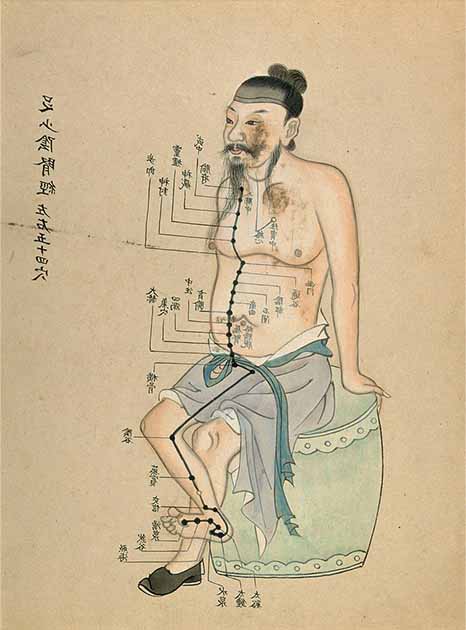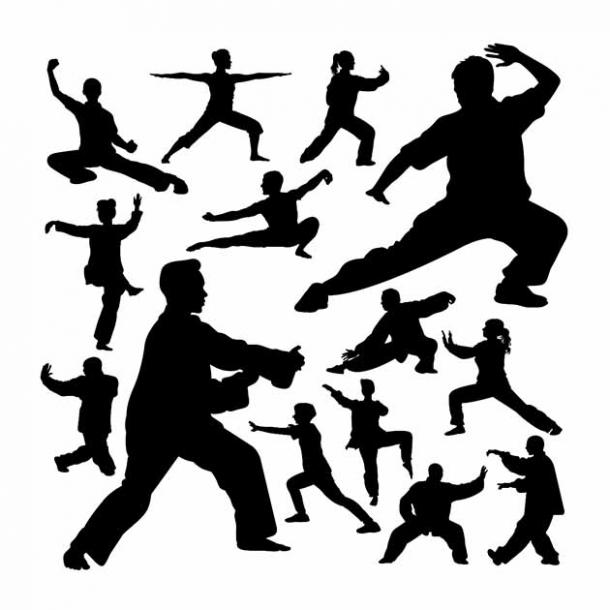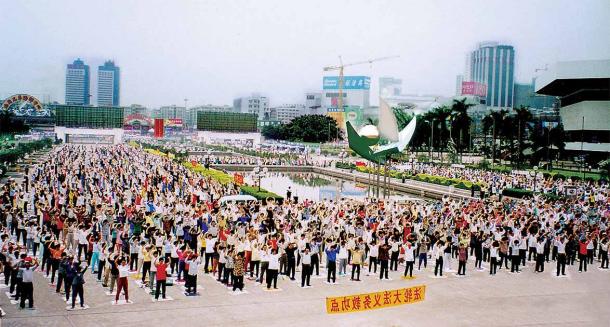Visit any park in China over the last few hundred years and you’re likely to see dozens of people practicing qigong. What started as a traditional Chinese treatment over 4,000 years ago has become a major health trend today. Now, people all over the world practice qigong, attempting to bring balance to their hectic modern lives. But where exactly did it come from and how has it changed over the centuries?
Qigong: Body Posture, Movement, Breathing and Meditation
Qigong is a combination of coordinated body posture , movement, breathing, and meditation. It is used to improve one’s health and spiritual well-being, as well as in martial arts training. It was traditionally used by the Chinese as a way to balance a person’s qi ( life energy ).
Whilst this may all sound like superstitious hokum to the scientifically minded, qigong’s medicinal benefits have been thoroughly studied. Since 1998, it has been recognized as a valid form of medicine in China.
Qigong has evolved over the centuries and today tends to have a more medicinal than spiritual focus. It is made up of different practices, forms, and techniques. In 2010 the Chinese Health Qigong Association officially brought in five new health qigong forms with the explicit aim of improving practitioners’ health.
Qigong is broadly split into two categories: dynamic/active qigong uses slow, flowing movements, while meditative/passive qigong uses still positions and focuses on breathing techniques to clear the mind.

Qigong exercise to treat involuntary seminal emission from the Xiuzhen miyao, a gymnastic qigong text of unknown origin, which was rediscovered and published with a preface by Wang Zai in 1513. It records 49 qigong exercises. (Wellcome Images / CC BY 4.0 )
Etymology of Qigong
Qigong can be split into two separate words, qi and gong. Qi means air, gas, or breath but is often used to refer to the idea of vital or life energy. All traditional Chinese medicine revolves around the idea of qi and the flow of life energy. Gong on the other hand translates as cultivation or work.
When combined with qi the two describe systems that seek to balance one’s life energy through hard work and commitment.
The term qigong as we use it today is actually relatively young. It became popular in the 1940s and 50s as a way to refer to the myriad Chinese self-help exercises under one broad umbrella. It was also used as a way to move away from spiritual focus techniques towards the general emphasis of science-based health.
The Ancient Origins of Qigong
Qigong, as we know it today, is an amalgamation of thousands of years of knowledge. Its roots date back over 4,000 years to ancient Chinese culture. Over this 4,000-year period, different parts of Chinese society developed and practiced different qigong forms. Each with its own theories and characteristics.
Traditional Chinese Medicine: Qigong techniques have been used in traditional Chinese medicine for thousands of years. The use of qigong in traditional Chinese medicine tends to focus on balancing the mind, body, and qi. It is believed a person can become ill or die when their qi levels are reduced or become unbalanced.
Daoism: Daoism can be traced back to around the 4th century BC although elements of it go back much, much further. Daoist qigong focuses on achieving longevity and gaining enlightenment.
Buddhism: Buddhist qigong techniques date back to roughly the Han Dynasty (206-202 BC). It combines qigong techniques with Buddhist teachings as a way of attaining spiritual enlightenment on the path of reaching Buddhahood. As such Buddhist qigong is more meditative and spiritual.

Qigong was also used as the basis of developing high level martial arts techniques. ( fennywiryani / Adobe Stock)
Confucianism: Elements of Confucianism may go back as far as three thousand years. Confucian qigong is a religious practice. The goal is to become a Junzi (a person of high stature). A Junzi is basically a superior person of high moral standing within Confucianism. Confucian qigong focuses on an awareness of one’s own morality.
Martial Qigong: Finally, there is martial qigong. Many traditional Chinese martial arts like Kung fu (or Gong fu) incorporated elements of qigong. The goal is to improve one’s inner balance for better defense capabilities.
Liu Guizhen – The Inventor of Modern Qigong?
Liu Guizhen is sometimes attributed as being the inventor of contemporary qigong. In 1947 he was working as a clerk for the Communist Party when he became seriously ill, suffering from tuberculosis and stomach ulcers. He weighed less than 80 pounds and was sent on sick leave. It was not expected he would survive, let alone ever return to work.
But survive he did! It is said that Liu went home and practiced traditional qigong exercises taught to him by his uncle, Liu Duzhou. A few months later he returned to work, thirty pounds heavier and much healthier. Perplexed, the Communist officials asked how he’d managed it and Liu explained to them it was all down to the traditional techniques they so looked down on.
In 1949 Liu coined the term qigong to describe the life-saving practices his uncle had taught him. This is sometimes seen as the start of the modern, scientific interpretation of qigong. The next few decades would be messy for both Guizhen and qigong.

By the mid-1990s, Falun Gong qigong-based exercise sites with thousands of participants, like this one in Guangzhou, China were a common sight throughout China but then the persecutions began. (ClearWisdom.net / CC BY-SA 3.0 )
Running Into Trouble: Qigong and the Authorities
Qigong would go on to have a messy relationship with the Chinese authorities in the 60s and 70s, as did the later Falun Gong qigong practices. During the Great Leap Forward (1958-1963) and the Cultural Revolution (1966-1976), the Chinese state heavily clamped down on many traditional Chinese practices that were seen as too “spiritual.” Qigong was clamped down on and the general public had little access to it. It was still used in state-run rehab centers and hospitals, however.
During the Cultural Revolution Liu Guizhen was imprisoned for 11 years, as he was seen as being responsible for the spread of “the poisonous weed of qigong.” He spent his time teaching his fellow prisoners qigong despite threats of torture and even death from Chinese authorities.
Following the death of Mao Zedong in 1976. the popularity of qigong exploded. Soon there were anywhere between 60-200 million practitioners of qigong in China. This began to cause problems. Some qigong masters began claiming almost superhuman abilities using pseudoscience as an explanation. And more than a few less than honest masters began forming cults for personal benefit.
This led to two more state clampdowns. In 1985 the National Qigong Science and Research Organization was created to regulate the different qigong denominations. Then in 1999, the Chinese state began to worry that old traditions of spirituality, mysticism, and morality were becoming too popular again, thanks to the widespread practice of qigong. Qigong clinics and hospitals were promptly shut down and spiritual movements that utilized qigong such as Zhong Gong and Falun Gong were banned.
Today, whilst still popular in China, qigong is strictly regulated. Instructors must be trained and certified by the government and qigong can only be practiced in state-approved forms. These forms focus on the medicinal aspect of qigong rather than the spiritual.

Today qigong is popular across the world as a form of exercise and comprehensive health regime. The silhouette of man practicing qigong exercises at sunset by the sea. ( Alexander Belinskiy / Adobe Stock)
Conclusion
The success of the Chinese authorities’ attempts at clamping down on qigong has been mixed. Thanks to the migration of Chinese people, tourism, and globalization in general, qigong is now practiced all over the globe.
Authorities may have attempted to clamp down on it but today qigong has largely returned to its roots. People from all over the world of diverse backgrounds practice qigong. Some of them do it for fun, some for exercise, and some for healing. Others however have studied qigong’s roots and use it for self-cultivation, spirituality, and meditation.
When begged by his wife to stop teaching qigong in prison, Liu Guizhen is reported as having said, “the future will confirm our work. One day the science we call ‘qigong’ will be known and judged as a precious legacy and treasure benefiting all humanity.” Today I’m sure he would be pleased to see he was proven right.
Top image: A man in black shirt sitting and doing qigong with his hands directing his body’s life energy or qi. Source: Anna / Adobe Stock
By Robbie Mitchell
 RSS Feed
RSS Feed















 September 13th, 2022
September 13th, 2022  Awake Goy
Awake Goy  Posted in
Posted in  Tags:
Tags: 













